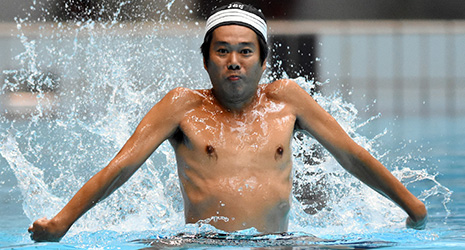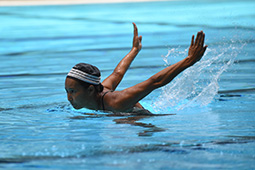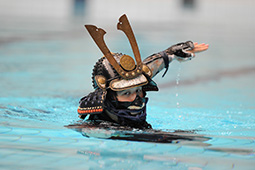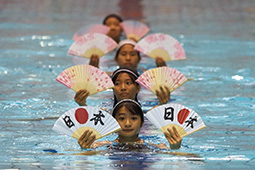INDEX
- English
- 日本語

The “flying mullet,” Nojima-ryu - English
- 日本語

Swimming with a parasol and folding fans, Koike-ryu

The “crane dance,” Nojima-ryu 
Armored swimming, Kobori-ryu 
A group performance with fans, Koike-ryu
August 2021
The Classical Swimming Arts of Japan

Nihon eiho (Japanese classical swimming arts), which developed as a martial art, differs from modern competitive swimming and is a uniquely Japanese way of swimming that has been passed down through the centuries and is familiar to people of different generations.

Since Japan is surrounded by water on all sides, its people have been diving into the sea in search of fish and shellfish since time immemorial. That is, swimming was a technique indispensable to daily life.
Eventually, swimming came to be used by samurai warriors in battle during the civil wars of the Sengoku period* (late 15th to late 16th century). The civil wars came to an end with the start of the Edo period (early 17th to late 19th century) and swimming was systematized as suijutsu, one of the martial arts practiced by the samurai warrior class. “Nihon eiho” has its roots in this suijutsu, and refers to a special Japanese swimming style handed down for several hundred years.
Yamane Kazuhisa, head of the Japan Classical Swimming Arts Committee of the Japan Swimming Federation, explains that Japanese suijutsu started developing around the sixteenth century, mainly in western Japan.

Yamane says, “In a time of constant warfare, combatants would sometimes have to fight across rivers or near the sea and the shore, so swimming was something samurai had to learn. Command of the sea was especially important in western Japan where the Seto Inland Sea was a strategic hub for maritime traffic. The sea was a battlefield as well. Noshima Island in the Seto Inland Sea was the base of the famous Murakami Suigun (Murakami navy). Swimming at the time meant swimming without getting your baggage wet, swimming in armor, getting quickly up on the gunwale from the water, diving, and stretching up out of the water to look afar, so it was probably breaststroke and treading water mostly.”
“I think people outside Japan can bring to mind scenes where people dive under water for long periods of time, which you sometimes see in ninja movies. Ninja habitually practiced hiding in water, but samurai also prepared for fighting in water and regularly practiced techniques for carrying weapons, ammunition, and food for battle without them getting wet. Breaststroke was optimal for swimmers to conserve energy by using the flow of the water while keeping their eyes on their destination. Meanwhile, treading water was suitable for several people to carry baggage together.”

By the seventeenth century, when the Tokugawa shogunate ushered in the Edo period and an age of peace arrived, suijutsu like many other martial arts came to emphasize spirituality and generated many schools. After that, in the latter half of the nineteenth century, with the demise of the Tokugawa shogunate and the end of the Edo period, the samurai class disappeared and thus the handing down of suijutsu as a martial art was temporarily interrupted. However, training pools and swimming schools similar to those of today were established across Japan, continuing the suijutsu tradition. It is said that these played an important role in preventing child drowning accidents at the time.
At present, the Japan Swimming Federation recognizes thirteen schools of Nihon eiho, and these all come together once a year to participate in the Nihon Eiho Taikai tournament. This year’s competition is the 66th and has swimmers compete in a variety of swimming styles. Events include seeing who can swim the 100 meters sidestroke the fastest and who can tread water holding iron dumbbells the longest.
Meanwhile, having developed as a martial art, Nihon eiho has generally been thought of as something completely different from the timed races of competitive swimming. Even so, out of the four competitive swimming strokes, breaststroke has many things in common with the ideas of Nihon eiho as both disciplines value each and every stroke, which some think is one reason for the many medals won by Japanese swimmers in Olympic breaststroke. Techniques like treading water and scissors kicks that are peculiar to Nihon eiho also come to good use in artistic swimming. The Hamadera Swimming School (Sakai City, Osaka Prefecture), which teaches the Nojima-ryu swimming that goes back to the Murakami navy, has produced a large number of Olympic athletes.

Yamane comments, “Nihon eiho competitions are held in pools nowadays, but the techniques were originally practiced in nature, such as the sea, rivers and lakes. In fact, if you are out at sea, swimming with competitive styles quickly makes you tired, but using Nihon eiho, which teaches the adept use of waves and surges, you can keep swimming for a long time. For example, Nihon eiho techniques are perfect if you want to swim in the summer sea while watching the sunset at your leisure.”
There are no timed competitions even in qualifying events of Nihon eiho. Advanced practitioners are required not only to master styles but also achieve unity with the water. This is likely a reason why Nihon eiho is beloved as a lifetime sport by people of all generations.
* During the Sengoku period, the authority of the Shogunate was lost, various warlords competed nationwide and there were many wars.

